Rewarded Video Ads have been a constant, dominating trend in free to play over the last few years. Starting with companies like Ketchapp and Futureplay, it became abundantly clear that games can drive meaningful revenue from video advertisements, and advertisers can find a captive audience in mobile players. In the last couple years, Video Ads have reached a tipping point. No longer seen as superficial revenue on top of IAP revenue, designing for video ad revenue has become the dominant revenue growth area for free to play companies. Designing for video ads has allowed for innovation in the maturing mobile space that is much needed.
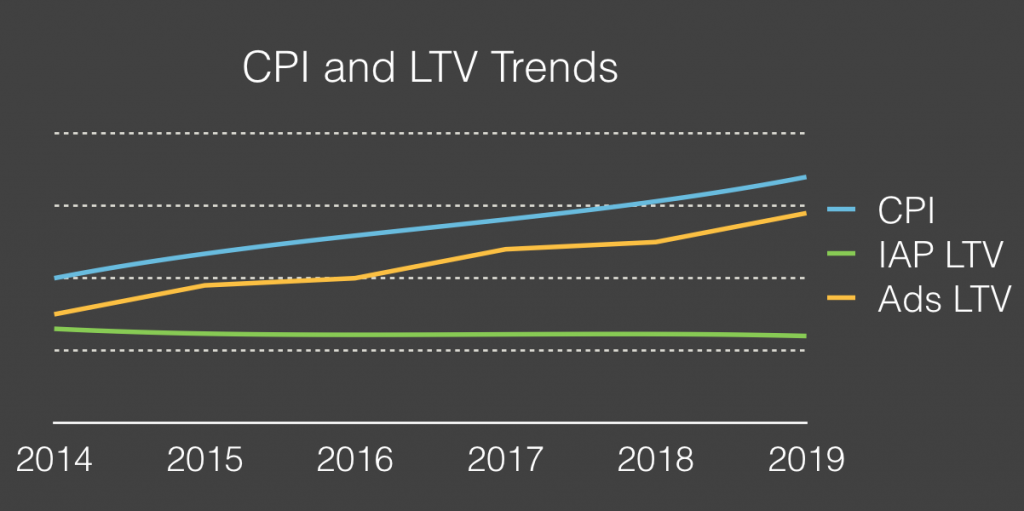
Source: SOOMLA Blog (an excellent source of info on Video Advertising!)
The rise of Video-Ad driven monetization has heralded in a new era within mobile game design. The casual segment has been dominated for years by the Match 3 Saga model with other casual categories struggling for meaningful revenue (ex. “with Friends” style games). Video Ads have opened up these categories because it monetizes on 100% of your user base. Instead of having to awkwardly cram in In-App Purchases into a casual title, developers can monetize off their active playerbase even if they don’t have a meaningful economy with anything to sell.
“The rise of hyper casual” it is called. Summarized here by Johannes Heinze of AppLovin:
“Players of hyper-casual games can be acquired at extremely low rates, so even though CPIs are increasing and gaining traction in the app stores is difficult, developers of hyper-casual games have a lot of opportunities. Hyper-casual games tend to be less costly to make, and users monetize almost immediately since ads are the primary revenue source, meaning that UA campaigns can be optimized early on. Hyper-casual games make the biggest share of revenue in the first couple of days, unlike IAP-heavy genres, where the most active users make the most money over time.” – Johannes Heinze, AppLovin
The rise of hyper casual category is exciting because it goes counter to what traditional free to play games have been moving towards: massive budget, multi-year long productions that are getting riskier and riskier. Hyper casual games are innovative, quick to make, and easy to market when done right.
Gram Games is one of many that successfully capitalized on the hyper-casual trend. Games like 1010! And Merged were quick to make, yet clearly generate more than enough revenue to support the mid-sized Turkey-based studio (now with an additional studio in London).
Gram Games’ most recent launch is “Merge Towns”, a mashup of a puzzle and idle game. The game has peaked at #3 top free downloads in the UK, and is within the top 20 downloads in the US. This game clearly shows the latest innovation in the video-ad driven monetization space and is an excellent guide for newcomers to space. Not only does it have strong proven video ad integration, it also supports an innovative core gameplay. Let’s take a closer look.
Core Gameplay
Merge Towns at the purest concept level is a Matching game core combined with an Idle game economy.
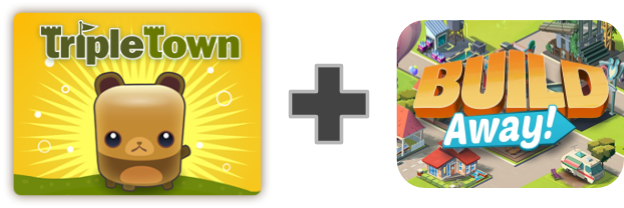
The core gameplay mimics that of Threes! and Triple Town in that you attempt to combine multiple of the same block to upgrade the square.
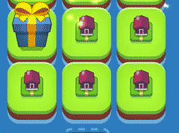
You can see above how the core is built. You can drag and drop any piece on top of another piece of its kind. There are no restrictions like Triple Town or Threes. Placing the same tier of a piece (a small house) on top of the same tier will upgrade the house to the next tier (a piece with 2 houses). This carries forward and forward throughout the game, creating more and more intricate pieces.
Whereas the goal in Threes And Triple Town was simply to survive for the longest time possible, Merge Towns is more akin to an Idle game. There are no failure states, there is just optimization of progress. Your goal is to generate pieces — so you can combine them — to make better buildings — which generate more revenue — to purchase better pieces. The core gameplay moves like this:
1. The first step is about generating pieces. Players can do this by rapidly tapping on a button, or by waiting.

2. With the generated pieces, players combine them to upgrade them and make space for more land and new pieces to fall.
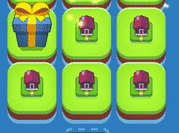
3. With the upgraded buildings, these generate faster soft currency.
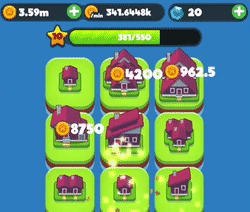
4. With the soft currency, players can purchase better pieces directly
Overall the gameplay feels significantly more approachable and casual than Threes or Triple Town. For Triple Town, the restrictions on movement and the loss condition make for a far more difficult puzzling experience. Merge Towns feels much more like a new take on an idle game mechanic (ex. Farm Away and Build Away’s core gameplay which is deconstructed here). Instead of simply asking players to tap-tap-tap their way to progress, they’ve added a thinly more involved matching mechanic which feels satisfying to complete.
Players don’t even have to pay that much attention to the numbers, the core gameplay of simply matching the highest tiered object possible works well on its own. It’s not so much a puzzle as it is just a pleasurable action.
What this says to me is that the key part that works for the Idle genre is the metagame and the economy. Clicking over and over again is just a relic of the Cow Clicker days — to innovate in this genre it will be about combining the economy of and idle with interesting core mechanics which have significantly more interest than tapping over and over. Merge Towns executes on this. Merge Towns appeals to a wide casual market while having the lasting economy of an idle.
Integrating the Idle Economy
To integrate the Idle economy with a new gameplay took some workarounds by the design team. If players can upgrade buildings on their own, what is the value of the currency generated?
Gram Games answered this by making soft currency the time skip currency. Players can purchase upgraded buildings directly with their soft currency, allowing them to make progress significantly faster as the economy naturally slows down with the exponential nature of the design.
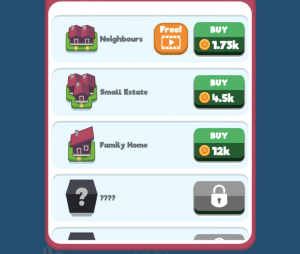
Players thus enter the store as part of the core loop, constantly aching to spend their soft currency to speed up their progression and purchase the highest upgraded buildings possible. It feels like an Idle economy, where I’m constantly making purchases to upgrade the rate at which I’m generating soft currency, but this feels very different. Something that all designers must strive for.
As time goes on, Merge Towns eventually opens up more tiles in which you can place pieces giving a small sense of Visual Progress. Your town can now get bigger and bigger. However, eventually, things do get boring as a usual idle economy does. Eventually the next major upgrade gets farther and farther away.
To keep players engaged when progress slows down most idle games use a prestige mechanic, forcing players to reset their progress in the current area. To make this appealing, games usually offer a permanent progress boost to the player, making their subsequent resets of progress allow them to get farther and farther in the progression. Merge Towns breaks this formula, and instead opts for a more heavy-handed design.

Eventually, new tabs open up on the right which introduces the player to new areas of the game. This offers up an entirely separate town to build up. Their soft currency is completely different, so progress in the first zone does not help at all to progress in the second zone. This is a far break from their idle game roots.

This design decision has some pros and cons.
On the one side, it feels casual because I don’t actually lose any progress — my initial town is still running and I can still keep upgrading it. All the visual progress that I’ve made upgrading my buildings is still felt. It removes the punishing feeling that most idle games can have.
However, it also means that my sessions will get longer and longer. While this game’s design already rewards players quite heavily for being active. As you progress the sessions continually get longer and longer to manage the multiple zones, making sessions more and more exhausting.
But in essence longer session length is what Gram games want. The longer their sessions — the more players stay within their game — the higher their Video Ads watched per DAU. Restricting session length too much actually isn’t in Gram Games favour. So Gram Games made the right design decision, as long as it doesn’t translate into exhausted players.
Advertising Strategy
Advertising strategy always revolves around getting the highest possible adoption and driving as many completed video ads viewed per DAU. More on this in our previous article.
For Merge Town, because their economy is so based on the Idle economy, they didn’t have to reinvent too much. Merge Town mostly takes cues from the dominant idle games like Farm Away and Build Away. However, they do make adjustments to make them work with the core merging interaction.
There are 4 key integrations of Video Ads:
#1 Welcome Back Bonus
Each time a player returns to the game they are greeted with a choice. Watch a video ad to double the soft currency generated while they are away, or lose out on this deal. Just as we’ve written about before, this is a no-brainer.

This integration is great for driving a high adoption. Right from the outset there’s a high adoption integration. Some scarcity + a clear benefit make this easy for a high percentage of your DAU to accept. However because it’s limited, it’s not great at driving a high quantity of views.
#2 Upgrade Rewarded Building
Throughout the game, there are also smaller rewarded video ad integrations which allow the player to upgrade a given reward for the cost of watching a video ad.

These integrations are great at driving quantity of views, since players can utilize them throughout a session without restriction. In most games offering video ad rewards like this without restriction isn’t possible, it floods the economy or gives too much progress away. However in Merge Town, because the economy scales exponentially, a small boost like this actually doesn’t really dent the overall economy.
#3 Double Production for 2 Hours
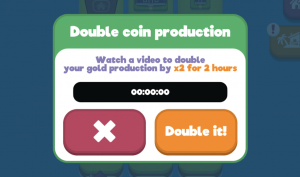
Similar to Build Away and Bit City (deconstructed here), Merge Towns gives the player the opportunity to double their overall coin production for an extended period of time for a video ad watch. This drives adoption (it’s an incredible deal) but is weak on quantity of video ad views due to its limited nature. This is also more likely for session design over monetization — giving players a compelling reason to come back to the game every 2 hours.
#4 Forced Ads in Flow
Lastly, Gram Games also has Ads forced upon the player when doing certain actions. When entering the shop (which happens multiple times per session) and sometimes when moving between zones (as you progress this happens more and more) you can be presented with a skippable full screen ad. They definitely are annoying, especially since they seem to appear randomly (most likely due to fill rates from advertisers).
Why would Gram Games opt for such a strategy? Isn’t rewarded video ads always better than forced?
This is most likely a strategy to drive the strongest revenue from players that won’t last forever. Merge Towns is a fun game, but it certainly won’t have the same staying power as traditional free to play games like Gardenscapes, Galaxy of Heroes or Clash Royale. But Merge Town doesn’t need to be like this. Not every game needs to be a 3 year epic hobby with clans and guilds. Which is why many of these video ad driven games are refreshing and are easy to market. They have instantly gratifying mechanics that most traditional free to play games wouldn’t utilize. Their design is simple making it easy to pick up and play compared to most free to play games.
On top of this, it allows Merge Town to monetize off the “No-Ad” version. Purchasing a In-App Purchase will remove the annoying ads, making their offers even more enticing for the power players.
So Gram Games’ embraces their shorter retention curve by their aggressive ad strategy. While it does no favours for their retention, they made a calculated trade-off between retention and revenue. If you know players aren’t going to be here a long while, retention isn’t king… revenue is.
In Summary
By having innovative, instantly gratifying core mechanics, Merge Town has made a game that feels immediately new and different. This game must be easy to market.
By connecting it to an idle game economy they’ve built a game that can last, and drive meaningful integrations of video ads for sustainable revenue.
For game designers in the market, Gram Games have shown that Video Ads and Hyper-Casual games have opened up new possibilities in the market. Now it’s time for us as game designers to adapt and embrace it.
View-to-play is fast becoming the new dominant monetization model in the mobile marketplace. For the last few years, game companies like Futureplay, NEXT Games, Gram Games and Ketchapp have shown that you can create successful free-to-play games which drive sustainable revenue without focusing solely on In-App Purchases. Games like Crossy Road, Tap Titans, and Endless Runners like Despicable Me have reported that more than 50% of their revenue comes from video ads.
Creating successful Video Ad integrations is more difficult than simply rewarding a video ad watch with in-game currency. In order to generate enough video views, games need to be designed with video ads in mind. For video ads to perform well we’ve established four core principles of video ad monetization:
- All video ad views are opt-in
- Game design that pushes the maximum number of views per DAU
- Ads give valuable rewards in a positive way for the player
- Ads complement in-app purchase, they don’t replace IAPs
Futureplay is one company that have followed these four principles and built two games (Farm Away and Build Away) that use view-to-play to full effect. Founded in 2015 in Helsinki, Finland their focus is on shipping games based on the idle / clicker genre. If you haven’t played this style of game, I recommend reading our overview of Clicker/Idle genre:
Great interaction design and slick presentation make these games a joy to play. Let’s dive into how they integrated video ads into the core loop:
Farm Away! and Build Away! Gameplay
An Idle game’s core loop revolves around producing as many coins as quickly as possible. In order to do this, a player must purchase exponentially costly upgrades that increase their coin production rate. It’s a positive feedback loop.
The objective for a player becomes maximising the efficiency of earning currency. The skill in these games is choosing which upgrades are the most efficient. Rather than digging too deep, remember that for players, increasing the rate of earning feels powerful — and upgrades that provide 2X or 4X increases to your coin production for short periods of time feel very rewarding as progress is noticeably sped up during your session.
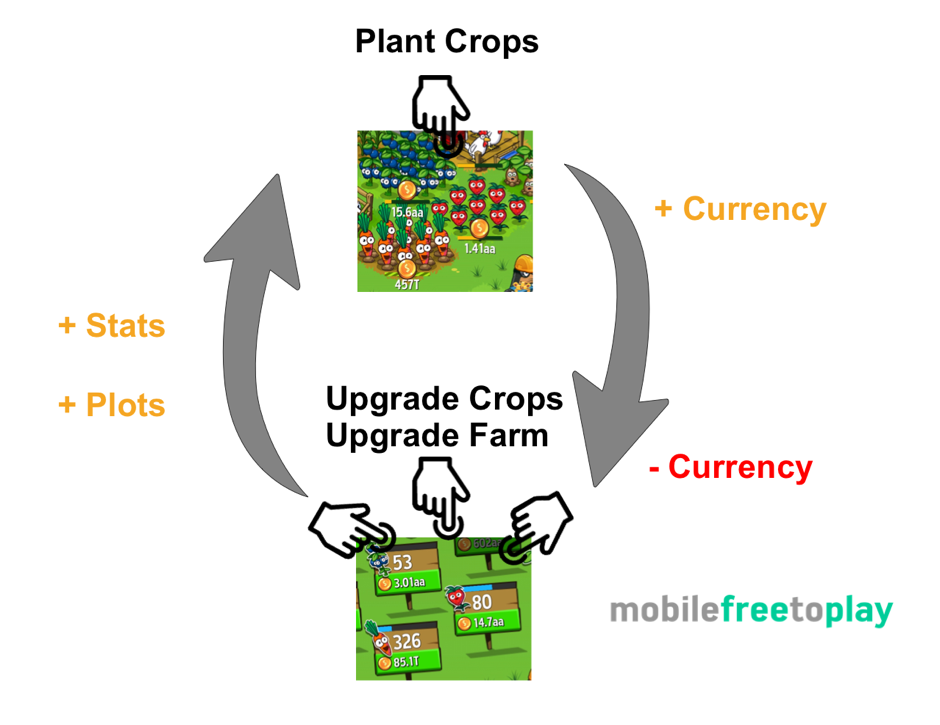
Increasing the rate of earning feels powerful
“Farm Away!” wraps the idle mechanic to planting and harvesting crops so that you can upgrade your crops and increase your rate of earning by buying more plots.
“Build Away!” uses a very similar system but you buy various building types and place them in blocks within a city.
Both games allow you to sacrifice all of your crops or blocks in order to get seeds in “Farm Away!” or keys in “Build Away!”. Investing into seeds or keys provide global growth bonus’ to help your future farms or cities.
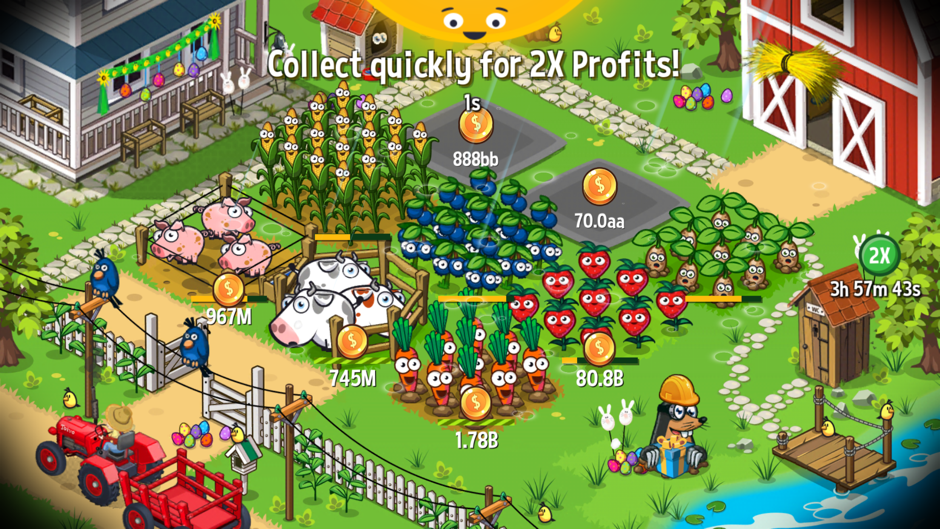
Video Ads: Opt-in + Attractive Rewards
Nobody wants to watch a video ad. So if you’re going drive a full video ad view you need to make sure it doesn’t feel forced (it’s opt-in) and players feel they are getting a benefit from it.
If you think of watching a video ad as a transaction of time (30 seconds) it will help you to design systems that respect the player’s choice. Just as buying an in-app purchase is asking people to sacrifice money to gain progress, here you are asking players to sacrifice their time to watch an advert. Asking players to do this not always possible or preferable, you might be sat on a busy train or having a romantic catch up with your girlfriend. Playing mobile games while having a romantic catch-up with your girlfriend is not advisable or you may find your romantic catch-ups become few and far between!
Therefore, allowing users to opt-in to view your video enables them to choose a time and place to sacrifice their time. People will very quickly learn which features of your game are powered by video ads. The clarity of the trade enables people to opt-in when they will get the most value for themselves. Clearly labelling the reward at the point where you choose to watch helps here. Enabling scheduling and power-ups that each work for different amounts of time enables a player to chose the most efficient trade for them at that moment in time. Having a breadth of options that caters for these needs leads to many more opportunities to view a video. More opportunities give a higher chance that any one of these might convert to a video view.
Making a video ad watch opt-in allows for scheduling, but making the reward feel positive and special will lead to higher conversions. Well designed rewards are those than enhance a player’s experience. For example, a boost to currencies the player would normally receive, increased speed to reward or a dramatic / exciting feature that isn’t normally available. As with in-app purchases, a strong sense of value makes watching the video feel worth it.
Rewards from video ads don’t only need to come from giving away currency or increasing the rate of currency gained. People appreciate novel experiences, limited offers or a chance at a grand prize.
FuturePlay uses 4 different strategies that each create a positive experience for their users. Remember as we discussed in the mobile video ads value chain increasing the number of views per DAU will lead to greater payouts in the end. So from a game design perspective building systems that can support 2-8 views in a single session rather than the classic 1 or 2 can have huge increases in monetisation.
1. Scarcity and Growing Value (Daily Double!)
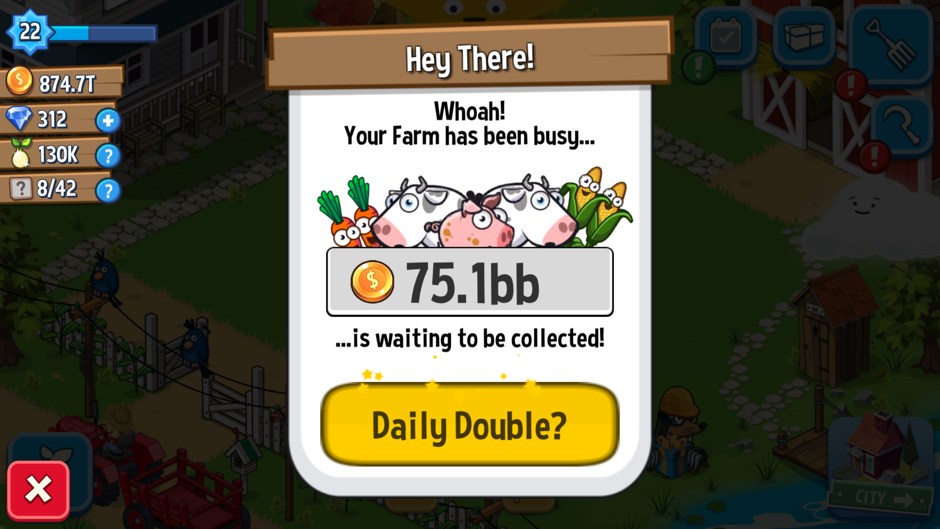
The strongest and most efficient video ad mechanic is the daily double. It offers to double the income you earned whilst away. Although very relevant to Clicker games as currency generation forms the core loop, a similar offer could be used in simulation games (currency doubling) or arcade (energy doubling) to give a highly valuable rewarding upgrade for the upcoming session. This has some very strong drivers:
- Obvious value that grows with time
- Presenting on appStart means everyone sees it and has the opportunity to opt-in
- Time limited availability which creates urge to take the deal now
The daily double effectively monetizes because it is high value (2x) and that starting value grows with time (seconds away from the game). Therefore, however long it has been, this bonus doubles it! 2X feels very rewarding for clickers and as a retention mechanic you get a larger boost no matter when you last logged, making your start feeling great!
Presenting a forced pop-up on appStart before the game begins, increases the % of your DAU which is likely to opt-in. People can only convert (earn you money) to an offer if they see it. People won’t feel bad if the opportunity is opt-in and valuable. As with all free to play designs you know your players are fickle, most players won’t even come back after a single day. Therefore forcing a high value, time-limited opportunity to kick start their game when they come back has the highest chance of conversion. For the view-to-play model to be successful you need to bump your average views per dau to 2-4. The way to do this is to be quite forceful. appStart provides the highest number of opportunities because it’s the first thing people will see.
The daily double is only presented once per session. By creating a scarcity in availability, people perceive the offer at a higher value even if the actual reward might be smaller. Putting people on the spot leads to more conversions. There are a number of psychology articles that talk about the effects of scarcity and it’s been used in marketing since the early 1970’s.
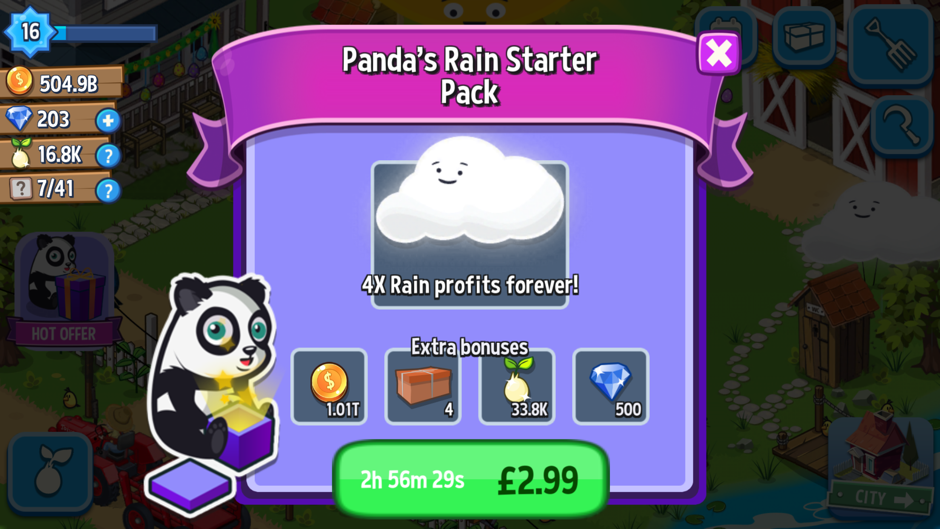
Any offer which is time or availability limited can create higher conversions due to a sense of urgency for players. To be effective the offer system should be presented to users multiple times across multiple sessions teaching people of its scarce nature. The more someone recognises a scarce item, the more likely they will be to convert when they see it. A good cadence for offers like this depends on the value of the reward. Once per session (Daily Double) has high cadence, low monetary value. A starter pack or time limited purchase (new players only) has high value, time limited. A special offer tied to an event or big update has high value and is availability limited can help to convert non-spenders into spenders. Video ad’s work best at the higher cadence lower value trades, whereas IAP works better at high value limited offers such as starter packs.
By creating a scarcity in availability, people perceive the offer at a higher value
2. Value over time (Session Doubler)

Clicker games benefit by being able to vary the rate of earning easily as their core loop supports a huge amount of depth.
By creating a large (2X or 4X) growth for an extended point of time the sessions themselves feel faster and progress feels quicker. This is quite like a feeling of increasing the flow of time (simulation) or even slowing down game-time in an arcade runner where a player’s game is made more comfortable. This form of trade adds value to your session, rather than short and sharp currency bonus’ that are quickly used up.
In other genres, it can be hard to create a similarly powerful video view because you need to keep a tighter grip over currency inflation. You should therefore consider speeding up an aspect of your core loop that encourages more play or more comfortable play of the core loop. For instance in a Base, Battle and Build (BBB) game, such as Clash of Clans, you might opt to increase the training speed of units by 2x by watching a video ad. This encourages more gameplay but doesn’t break your economy, it increases the number of battles played which positively reinforces the core loop.
If you have an RPG or adventure game then you might improve drop rates for 4h after watching a video ad encouraging people to continue to play longer sessions in order to maximise the benefit of the ad. Using video ads to strengthen the number of times a core loop is performed helps reinforce the positive moments and maximise the efficiency of a player’s time, creating a win-win scenario.
3. Short and Sharp Powerup (Instant Gratitude)

People run into situations where they need a little bit of help to achieve a gameplay goal. Creating a novel and fun power up that provides a short but sharp economic boost to help them reach a goal in that session. Futureplay turns this relatively simple power-up into a moment of joy for the player by encouraging them to interact intensely with the core action of harvesting in FarmAway! or collecting income from buildings in BuildAway! 20 seconds feels natural and a user can further increase the value by swiping as quick as possible to get an even bigger bonus.
Positive actions encourage a player to engage
Power-ups like this work by creating large environment changes such as increased animations, novel buildings or rare characters. The aim should always be to leave the user with a positive feeling. Some users may even watch a video ad in order to play the 20s mini-game. Think of a feature that fits your theme and allows people to play intensely for a short period of time, this might be doubling attack speed of a unit or increasing the power/size of in-game power ups in a match3. Think about ways you can trigger an exciting and special moment in your game that is unique but powerful to users.
4. Content Unlock or 1 More Life – (Unique Ability)

Certain features within your game might be critical to a player’s progress or score. In clicker games sacrificing your progress for global power ups is core to reusing the loop. Futureplay created a great and simple 24h blocker to prevent instant sacrifice. Players can skip this wait by watching yet another video ad. Patience is a virtue, but enabling players to gratify themselves instantly increases your views per DAU. Endless runners and frustration games use this very effectively to help people continue their progress in an attempt to get the highest score for a single run.
Unique abilities or instant gratification work so long as they are opt-in and don’t break your core game loop. Every game is different but by creating options and presenting them at different points allows people to choose when to feel clever.
Stack and Extend Video Views
The 4 different methods of watching a video are all unique but tied to positive actions that help a player to progress in their game. By providing 4 different features to watch a video, Futureplay has maximised the opportunities for players to watch a single video. In order to really boost their views per DAU, they have made more positive and valuable reasons to watch more than once.
- Every video views bonus stacks. So if the Session Doubler and Instant Gratitude feature are used together and effect 2×4 = 8x growth for a short period of time.
- Extending the period of certain bonus’ can occur by watching more than one video, this helps players to schedule their time in the game.
Effectively providing players with more opportunities to engage with video content around a feature will increase your views per DAU. Stacking of video views works well as long as you have a robust economy, be very careful that too many trades for currency or in-game growth don’t break late game systems in the game. When in doubt block players from too much stacking or extends. 2 or 3 stacks is enough for any single session. In this way, you can be sure that players need to keep coming back day after day and engaging with your game over a longer period of time.
At Slush in 2015 Futureplay revealed the Launch DAU and ARPU for FarmAway! Launch numbers and a staggering $0.09 ARPU during the launch window. Although they might not have maintained their high ARPU, it still shows what is possible for games that use the view-to-play model.

Watch the full video of View to Play by Futureplay at Slush 2015 – https://www.youtube.com/watch?v=TE6mF6VCxHA
Conclusion
View-to-play monetisation is now large enough to support gameplay mechanics that don’t work well with an IAP model. The biggest mistake companies make when trying to integrate the model is not providing enough opportunities for players to watch. Each of these opportunities should provide a positive experience either through value or interaction with the mechanics. High-value trades lead to a greater conversion of videos, but be careful that your economy is robust enough to handle this. When looking at your analytics make sure to track the video views per DAU in order to create features that lead to higher views. As the name itself makes clear View-to-Play requires views to generate revenue, use this to guide your development. View-to-Play is not applicable for all genres, but for some, it will be more lucrative than in-app purchases. Be sure to stick to the four guiding principles of view to play and track your video views in your analytics accurately. View-to-Play is here to stay and gives you more options to create financially successful games outside of the standard Match3, BBB or RPG mechanics.























